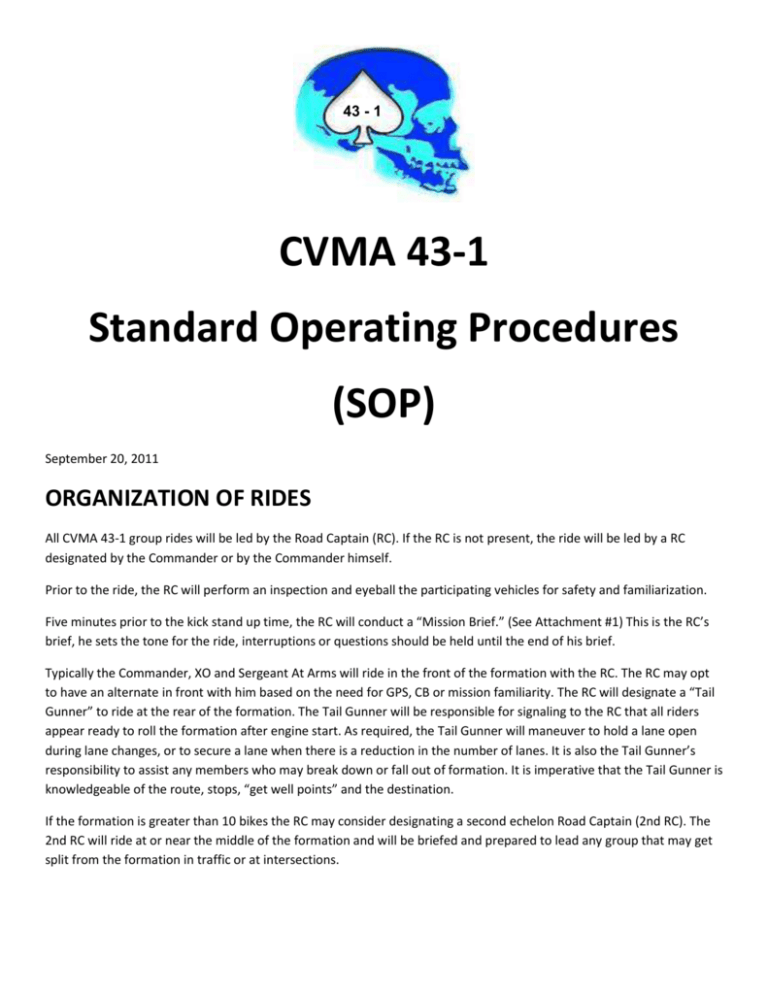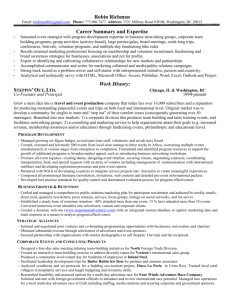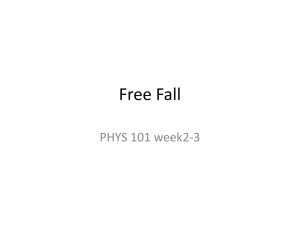CVMA 43-1 Standard Operating Procedures (SOP)
advertisement

43 - 1 CVMA 43-1 Standard Operating Procedures (SOP) September 20, 2011 ORGANIZATION OF RIDES All CVMA 43‐1 group rides will be led by the Road Captain (RC). If the RC is not present, the ride will be led by a RC designated by the Commander or by the Commander himself. Prior to the ride, the RC will perform an inspection and eyeball the participating vehicles for safety and familiarization. Five minutes prior to the kick stand up time, the RC will conduct a “Mission Brief.” (See Attachment #1) This is the RC’s brief, he sets the tone for the ride, interruptions or questions should be held until the end of his brief. Typically the Commander, XO and Sergeant At Arms will ride in the front of the formation with the RC. The RC may opt to have an alternate in front with him based on the need for GPS, CB or mission familiarity. The RC will designate a “Tail Gunner” to ride at the rear of the formation. The Tail Gunner will be responsible for signaling to the RC that all riders appear ready to roll the formation after engine start. As required, the Tail Gunner will maneuver to hold a lane open during lane changes, or to secure a lane when there is a reduction in the number of lanes. It is also the Tail Gunner’s responsibility to assist any members who may break down or fall out of formation. It is imperative that the Tail Gunner is knowledgeable of the route, stops, “get well points” and the destination. If the formation is greater than 10 bikes the RC may consider designating a second echelon Road Captain (2nd RC). The 2nd RC will ride at or near the middle of the formation and will be briefed and prepared to lead any group that may get split from the formation in traffic or at intersections. RIDING FORMATION Unless specifically briefed otherwise, the “standard” formation is “two second staggered.” The RC will ride in the front left position, the Tail Gunner will attempt to ride in the aft left position, if there is a 2ndRC, he will ride in the mid pack position. To optimize visibility and situational awareness in very large formations, the RC may opt to brief and ride in the center of the lane and may brief the Tail Gunner to do the same while the remainder of the formation rides staggered. Sidecars and trikes will always travel in single file at the rear of the formation just ahead of the Tail Gunner. Any “guest” (non CVMA) riders will ride behind the CVMA riders but in front of the Tail Gunner. When in stop and go traffic, closely spaced controlled intersections, or when waiting at stop signs and traffic lights, the formation will ride in a side by side “parallel” formation. When accelerating or turning from a parallel formation, the bike on the left will be allowed to go ahead of the bike on the right. When riding in challenging environment or terrain, or when riding on narrow roads, the RC may signal for single file formation. (2‐3 second spacing) When transitioning from a staggered formation to single file formation, the bike on the left will be allowed to go ahead of the bike on the right. UNIFORM All CVMA members are expected to display their patch on group rides unless precluded by foul weather gear. SIGNALS Riders should pass on hand and turn signals initiated by bikes ahead. Ready to ride: “Thumbs up” high enough in air to be visible to Lead Bike. Staggered formation: Two fingers (first finger and little finger) point to the sky on top of the helmet. Single‐file formation: One finger points to the sky on top of the helmet. Back off: Palm of left hand shown to group, pushing motion toward rear of bike. Slow down: Left arm is held out straight, then move hand and arm up and down Smoky alert: (police or emergency vehicles) ‐‐ Hand taps top of helmet several times Speed up or close ranks in formation – Circling hand over head Pointing to the tank: No matter what your reason, pointing to the tank on your bike will be telling everyone that you need to stop as soon as possible. This may be because needing fuel, to hit the head; because you are having a mechanical or equipment problem; because your co‐rider is uncomfortable; because of a medical problem. The affected bike can count on the Tail Gunner to stop with him to try to help him. LANE CHANGES: Whenever possible, lane changes will be executed as follows: RC signals lane change. Riders pass signal. The Tail Gunner secures lane if possible RC executes lane change followed by formation If formation is split up by a car in traffic, the rider in front of the car may gently roll off the throttle creating a gap (executing a “pick”) for fellow riders to rejoin the formation. TRAFFIC LANE SELECTION: The RC will move as an individual to whatever position is required to maintain a safe formation. Riders will travel in the specified formation generally behind the RC as appropriate and safe. Lanes are counted from left to right. The left lane is often referred to as the “Fast” or “Passing” lane, and is counted as lane number one. Remaining traffic lanes are then counted up until the right most, or “Slow” lane is counted. The RC will attempt to lead the group in a single lane when conditions permit and: The traffic flow appears to be most consistent with the speed of the group (using lane changes only when necessary to pass slower traffic or to avoid a hazardous condition); and to avoid blocking faster surrounding traffic. On highways with two or more lanes each direction, the group will normally travel in the number two lane allowing faster traffic to pass to the left, except when passing slower traffic on the right. On highways with three or more lanes in each direction, the group will normally travel in the number two lane keeping the right lane open for other vehicles entering and exiting the highway, and the left lane(s) for traffic to pass. CVMA 43‐1 Does not lane split on group rides. DO NOT ATTEMPT TO BLOCK CARS OR PREVENT CARS FROM ENTERING THE FORMATION, THEY ARE CALLED CAGES FOR A REASON. If a car is insistent or threatening safety, roll off the throttle. BREAKDOWNS If there is a breakdown or a necessity for a rider to pull over (bee sting, physiological incident, psychological incident, etc), the rider will clear the formation. The Tail Gunner will pull over with the problem rider. All other riders are expected to maintain the formation (or as briefed). In the case of large formations, it may be necessary for the rider now riding in the recently vacated Tail Gunner position to ride ahead and notify the RC of a dropout. The RC will proceed commensurate with the mission brief. (Proceed to pullover expeditiously, proceed to the “get well point,” proceed to the destination. LOST WINGMAN If a rider or riders become separated, they should continue on the ride route seeking to join up with the formation, the 2ndRC, the Tail Gunner, or another rider. If no other riders are found, proceed to the fuel/food stop, “get well,” or destination (as briefed), and upon reaching that point, attempt phone contact with the RC. If no contact, leave a message with intentions and associated times clearly expressed. WEATHER AND ROAD CONDITIONS In the event of encountering changes in weather or road conditions, the RC will pull over in a safe location for the formation to change clothing. Changes in speed, formation, interval and frequency of stops will be briefed by RC. In the event of dense fog, riders should exit the roadway at the absolute earliest opportunity. If unable to exit the roadway and progress is unsafe, park the bikes and self as far away from potential collision as possible, even if it means walking away from the bikes’ immediate location. ETTIQUETTE CVMA serves as ambassadors for all veterans, and as such, remains respectful to all motorcycle clubs and associations. IAW motorcycle etiquette, when encountering other rider groups, CVMA 43‐1 will endeavor to allow the Commander, XO, or RC (in order) to make the first contact or introduction. If arriving at a motorcycle event hosted by others, consider allowing the host club to approach first. When socializing with members of motorcycle clubs be cognizant of asking extensive questions. What may seem like casual conversation to you, may seem like an interrogation to the other party. Should you encounter a “downed” rider from a motorcycle club, it is appropriate and expected to render first aid until another member of his club arrives and then defer to the fellow member. Do not, under any circumstance, remove the downed rider’s “colors.” COMMON SENSE Fuel: Always begin a ride with adequate fuel. Ride your own bike: Irrespective of formation concerns, a rider should always ride their own bike first. Never allow the formation to exceed your own comfort or capabilities, whether it be speed, terrain, weather, visibility, or traffic conditions. Remember, the easiest pace and smallest speed changes are near the front of the formation. Difficulty or disagreement: If you are having difficulty riding with another rider, you should first attempt to move away from them in the formation. At the next stop, attempt using all the tact and interpersonal skills that you learned in the military and discuss your concern with the individual. If necessary bring it up with the RC and Sergeant At Arms. Complacency versus anticipation: Avoid the “Sled Dog” mentality and complacency when in formation. If you find yourself staring at the taillight in front of you, you are doing yourself and your fellow riders a disservice. Looking ahead allows a rider to analyze and anticipate accelerations, braking, hazards and lane changes. Compel yourself to frequently raise your scan to the horizon, including mirror checks. The taillight ahead of you will still remain in your field of view and you will increase the safety factor for yourself and the CVMA riders behind you. REDUCING THE “rubber band effect” While in “cruise” attempt to maintain the briefed interval Avoid unnecessary delays at lights and stop signs All riders should scan ahead to notice and react quicker to changes in speed RC and riders refrain from “hard” accelerations RC executes gradual speed changes, especially on and off ramps and mountainous terrain. SPEED and INTERVAL: The RC will establish and maintain a uniform speed consistent with the ability of the least experienced rider, surrounding conditions, and the number of bikes in formation. This is especially important when considering new riders, new members or visitors. The RC should continually check his mirrors to insure the formation is in good order. All riders will make an effort to maintain the same speed to minimize the effect of irregular speeds on riders at the rear of the group. All riders will maintain a safe distance and lane position between themselves and the rider directly ahead consistent with existing road, traffic, and weather conditions. SAFETY: At 50 mph you have less than ½ of the Kinetic Energy that you have at 71 mph. At 40 mph you have less than ½ of the Kinetic Energy that you have at 57 mph. Kinetic energy can be dissipated by tire friction with ground or by your body frictions with the ground…anticipate the threat and slow early. SAFETY IS THE BOTTOM LINE! THE MISSION IS UNSUCCESSFUL IF A RIDER OR BIKE IS HURT OR DAMAGED. RESPONSIBILITIES: ROAD CAPTAIN: Has full charge of the group until arrival at the destination. The RC will: Lead the group ride in a manner consistent with the objectives and guidelines established in this SOP consistent with his best judgment in situations not specifically covered in these guidelines. Brief Tail Gunner and Road Guards on the route, responsibilities, and other details pertinent to the ride prior to departure. Conduct a briefing prior to departure. Exercise the responsibility for the final decision with regard to ride termination due to inclement weather, hazardous conditions, or other difficult or unsafe conditions. Instruct any rider to ride in a specific position within the group, or leave the group entirely, for reasons of misconduct, disorderly or unsafe riding, or faulty/unsafe equipment. Common sense and tact should be used. Ensure a well maintained First Aid kit is available. Ensure a well maintained tool kit is available. Designate a 911- notification caller within the group and identify other riders with cell phones, first aid kits, and tools. Establish and maintain a uniform speed consistent with road, traffic, and weather conditions to accommodate the abilities of the least experienced rider. Exercise responsibility for initiating all maneuvers within traffic in a safe manner. Generally lead the group ride in the standard formation – staggered, double file, in one traffic lane. Generally lead the ride from the front of the formation, riding just to the left of lane center. Maintain a safe interval from traffic in front of the formation. This distance may be increased at the discretion of the RC, but will not be decreased. Adopt a single-file formation when conditions warrant. Conditions may include poor visibility, narrow road, mountain / curvy roads, traveling directly adjacent to parked vehicles, or any other condition which may severely restrict the ability of riders to perform emergency avoidance maneuvers. TAIL GUNNER: The Tail Gunner will assist the Road CPT in the performance of his/her duties and maybe required to assume the duties of Road CPT in his/her absence. The Tail Gunner will: Be responsible for bringing First Aid Kit to the ride. Be responsible for bringing a well-stocked tool kit to the ride. Ride at the rear of the group (except when conditions dictate otherwise) unless required to take on the responsibilities of the RC. Observe any hazardous conditions or conduct, take immediate corrective action, and inform the RC at the earliest safe opportunity. Generally ride where he can best see the formation. Lane protection is the Tail Gunners added responsibility. On the highway, as the group prepares to make a lane change, the Tail Gunner will make the lane change as soon as is safe to do so, followed by the RC, then the remainder of the group. ROAD GUARDSs: The Road Guards will assist the Tail Gunner in the performance of his/her duties and may be required to assume the duties of Tail Gunner in his/her absence. The Tail Gunner will: Riders should avoid physically blocking intersections At stop sign intersections or during ride launches, the RC may request a rider to serve as a traffic observer to flag fellow riders through an intersection safely. Break off with Tail Gunner to recover any member who makes an unscheduled stop. Questions concerning this SOP may be addressed to the Chapter Officers and or the State Representative. ________________ State Representative ___ ______________ Commander ________________ Executive Officer ___ ______________ Sergeant at Arms 1 CVMA 43‐1 RC BRIEF 2 HOLD QUESTIONS TO THE END! 3 Alt RC: ______2ndRC_______Sweep:_______ 4 New Members: _____ Non Members:_______ 5 FORMATION: (Stagger, Single, Positions) 6 SIGNALS: (Standard/Non Standard) 7 PHONE: RC/AltRC/Tail Gunner/Chase/Destination) 8 ROUTE: SPEED: 9 STOPS: Fuel @100mi/Meals/GetWell@50mi. 10 LANE CHANGES: BOTTLENECKS: 11 DESTINATION: Recognition/Parking 12 ENVIRONMENT: WX/Sun/Wind/Rain/Fog 13 DROPOUTS/BREAKDOWNS: 14 Formation stays together!!!! 15 Tail Gunner Duty 16 Plan: 17 Large Group/Important mission: 18 Formation goes to next stop 19 Small Group/Unsafe environment: Formation pulls over at next exit 20 Small Group/Safe environment: Formation pulls over ASAP 21 SAFETY/MEDICAL ISSUES 22 TRIKES & CAGES: 23 QUESTIONS: 24 BLESSING: Thanks/Safety/Those not here/Troops






